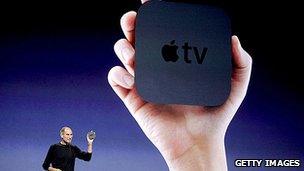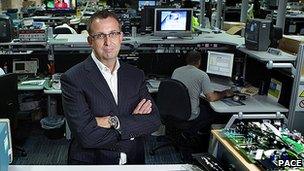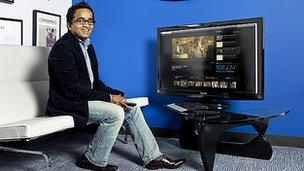Is the internet going to be the death of television?
- Published
- comments

Are you sitting comfortably: Will technology sound the death knell for traditional broadcasters?
In August 2010, the end of the age of television as we know it was widely predicted.
The US pay TV market had suffered its first ever drop in subscribers. In the end the economy was roundly found to blame, with cable packages being sacrificed as families were forced to tighten their belts.
But some commentators pointed to this as the inevitable result of the growth of on demand and over the top offerings available on the internet.
So is technology killing what we think of as traditional television - and taking pay TV operators with it?
It's a confusing picture. Nielsen, who track US television viewing habits, have reported a drop in television ownership - albeit from 98.9% to 96.7%. DVD sales are falling, while Netflix recently overtook cable operator Comcast to become the biggest subscription video service in North America.
IMS Research however is predicting digital cable TV subscribers in the US will increase by 7.8m between 2010 and 2015.

Apple TV lets users watch streamed video from iTunes and 'over the top' services on their TVs
YouTube, Hulu, iPlayer, Netflix and other 'over the top' (OTT) services, not to mention illegal downloading, all offer alternatives.
Apple and Google have both launched OTT services that let consumers play online content through their televisions, although Google's service is only available in the US.
We're watching more video than ever before this way. But we're also watching more television. What is less clear is where the broadcast industry is ultimately headed.
Ask the experts
So what do those in the industry think lies in store?
Neil Gaydon is the chief executive of pay TV technology developer Pace. They manufacture set-top boxes and other technology for some of the world's biggest cable and satellite operators.
He points to a rise in subscription figures over the last two quarters as proof that pay TV is healthier than ever.
"All the latest evidence is zero cord-cutting [using devices like laptops and tablets instead of TV sets] - zero, and actually all over the top is doing is providing other services," he says.

Pace CEO Neil Gaydon says convenience and ease of use mean pay TV is still attractive to consumers
"And if you look at TV viewing figures, it's the highest it's ever been."
He also points to the what he sees as the failure of Apple TV and Google TV to take off.
"The challenge to pay TV is greatly exaggerated - OTT has certainly pointed to the desire people have to watch what they want, when they want.
"What OTT hasn't answered, it doesn't have a business model yet that describes how it will make money."
Mr Gaydon doesn't see pay TV standing still. In his view, OTT has sounded a wake-up call to operators to develop hybrid services.
"The set-top box will morph into a media gateway," he says.
"If you fastforward, and you think about the home of the future, you will have to have a hub, a media gateway, some form of device that's going to manage a suite of services."
On demand
Not everyone is quite so confident the set-top box will survive the change.
Suranga Chandratillake is the founder of blinkx, a video search engine and aggregator.
"Every device will have an internet connection as standard, that's increasingly the case already. I think set-top boxes are a temporary business at this stage," he says.

Suranga Chandratillake says that on demand is here to stay
Despite this, Mr Chandratillake is not predicting the end of television as we know it.
"I think that the device will live on, I think that we'll continue to have large screen devices whether we call them TVs or not.
"But while linear will remain popular, I think you will see massive growth in on demand. I don't know to what extent these two things are cannibalistic."
The success of services like Netflix, he says, is proof consumers are willing to pay for reasonably priced services.
"I think partly we'll pay for it through small upgrades to our satellite, cable or broadband bills.
"The other way is through advertising - there'll be software or cloud services, you'll use a lot of them for free, but you'll be shown ads in the middle of them.
"I think though there are certain aspects of linear consumption that will remain with us. We'll all still watch the World Cup final at the same time."
Sports night
Irdeto's Christopher Schouten agrees.
"I think there's some content that will always be best served in a linear fashion, and that's definitely sports.
"We've seen a new category and that's reality. People prefer to watch the X Factor as it's happening, rather than after the fact.
"There's still a lot of value in that kind of content, but I would argue it is diminishing."
Irdeto is a global software security and media technology company. It has over 500 customers, mainly in the pay TV area.
Mr Schouten says most consumers still fall into the "TV traditionalist" category, who are happy with cable or satellite.
But this is changing.
"We clearly see other groups starting to splinter off into becoming what we call digital dabblers, people with a casual interest in media, but when they're interested it has to be exactly what they want and it has to be on demand.
"And then there are the media die hards, it has to be on demand, flexible, personal and portable.
"I think the over the top experience has been very beneficial to the market, because it has stimulated traditional pay TV operators into waking up, and realising consumers want a more on demand experience, that meets the criteria of what we call media 3.0, this anytime, anywhere content experience."
All of this is also dependent on where you are in the world however.
"If we look at industry trends, there are many markets where broadband is not yet as advanced, where [the set-top box] will be the dominant model for some countries."
Illegal downloading remains a threat, according to Mr Schouten, but he encourages customers to see it in terms of a competitor. One they can learn from.
"For the advanced customer there are three major competitors. There's pay TV operators, over the top and piracy.
"When we as an industry give consumers a legitimate option that meets their requirements, many of them will pay for it. Giving people what they want is always the best way to get them to behave differently."
So it seems the future may be a bit of a mixed bag.
"There is still a groundswell of people that come home and turn on the TV to watch regular programmes at a regular time. A lot of people still build their home life around that sort of thing," says Paul O'Donovan, of technology research specialists Gartner.
"The pay TV market will change from the multiple channels we have today. Out of 300 channels most people only watch seven, but dip into others.
"Clearly people like on demand, and there's been a lot of uptake and interest.
"I think the future is more about video on demand, and watching content when you want to watch it."